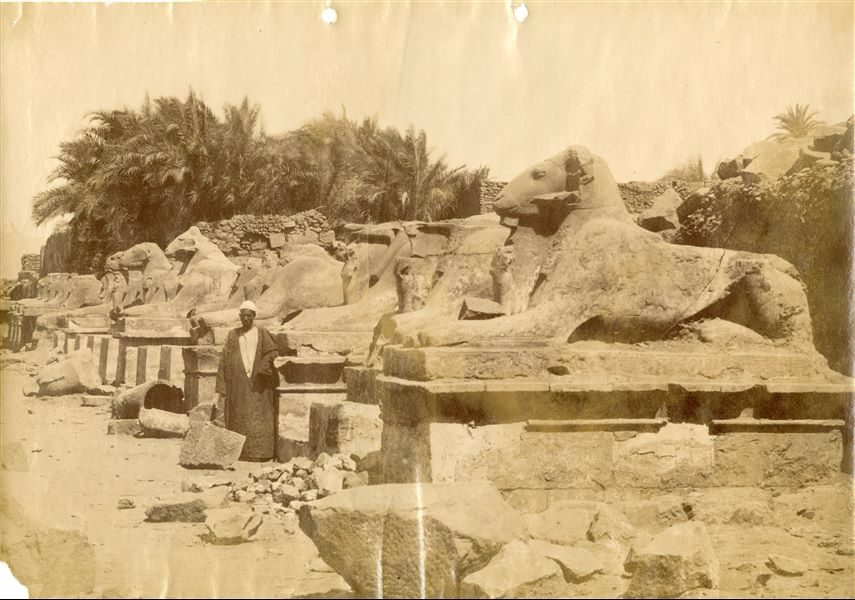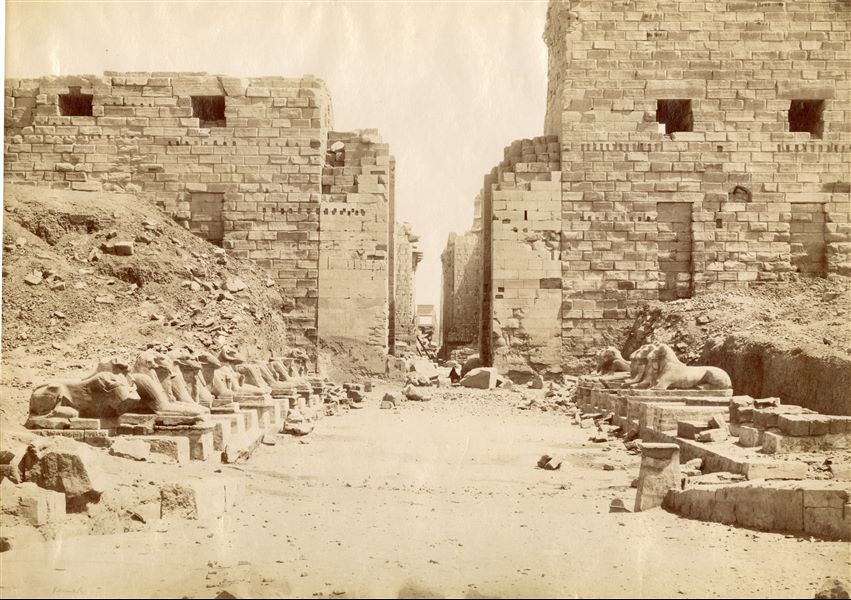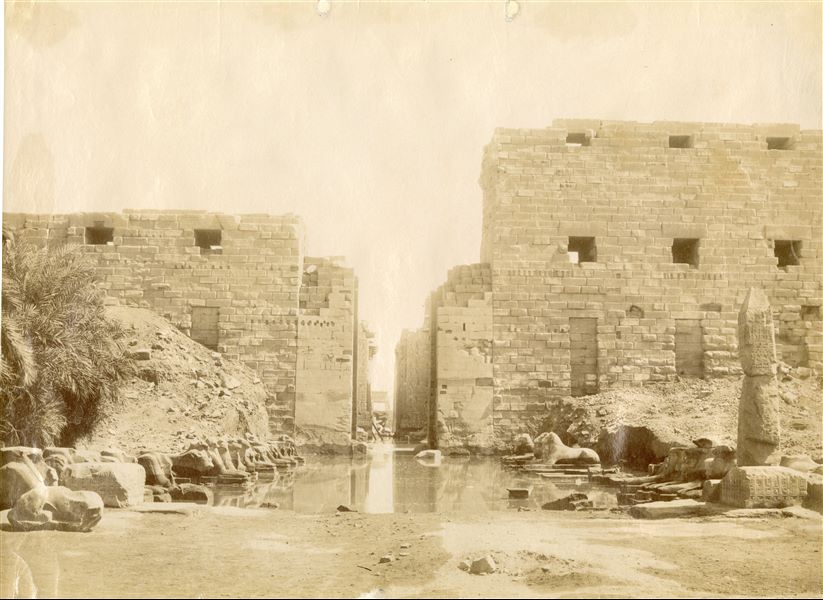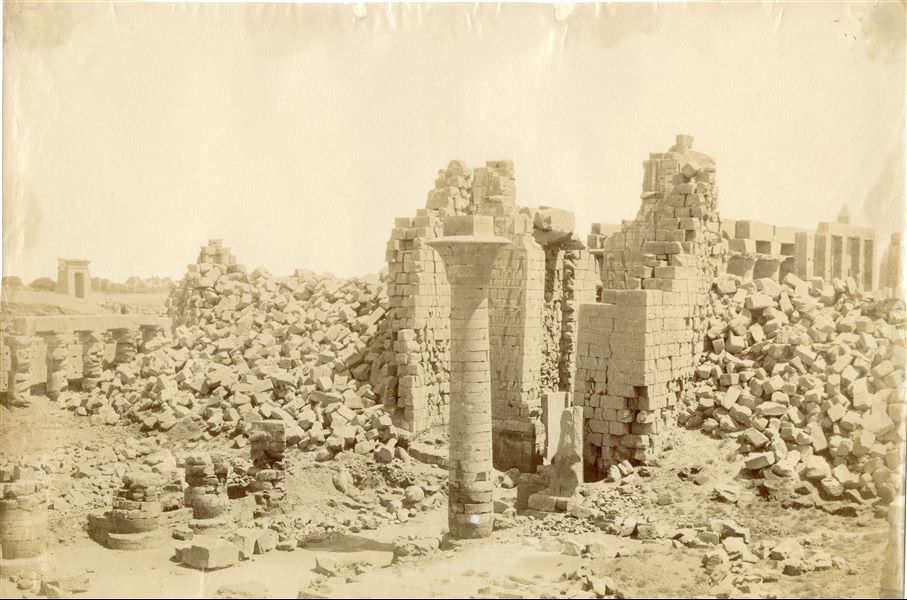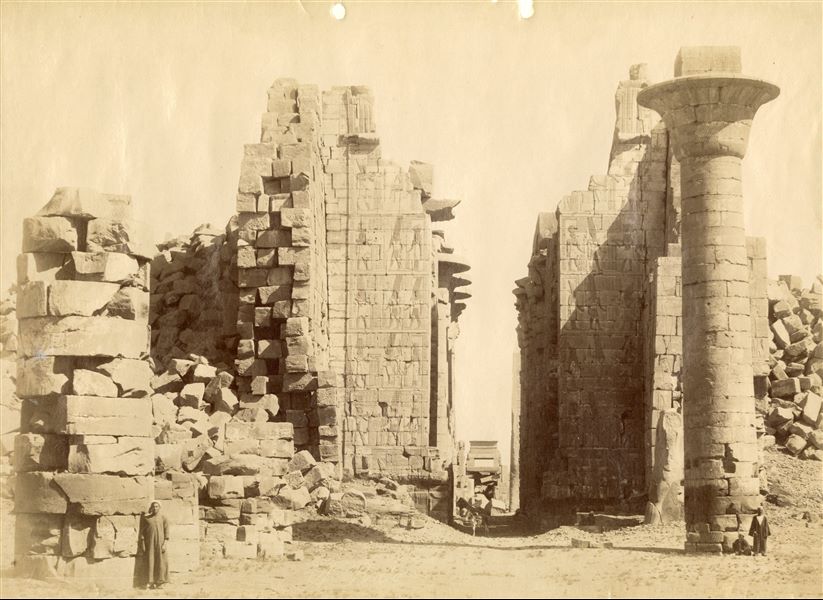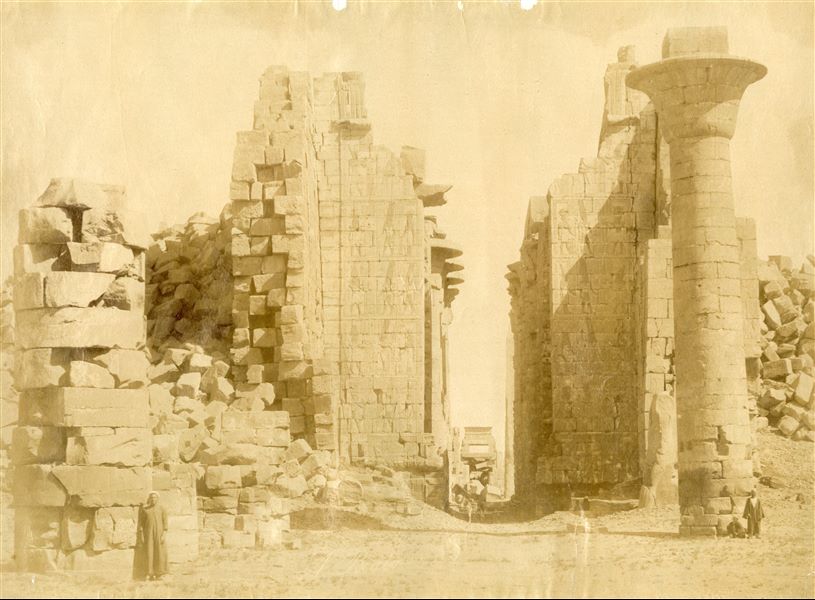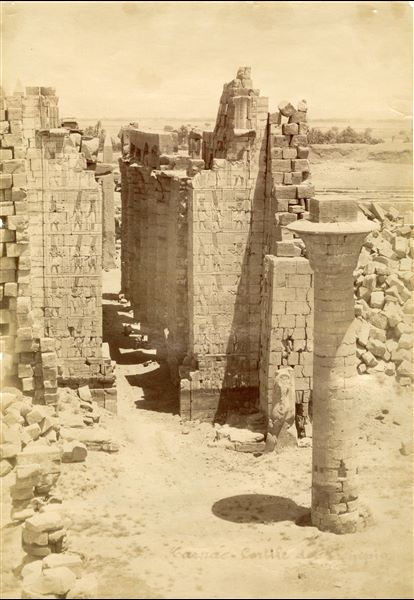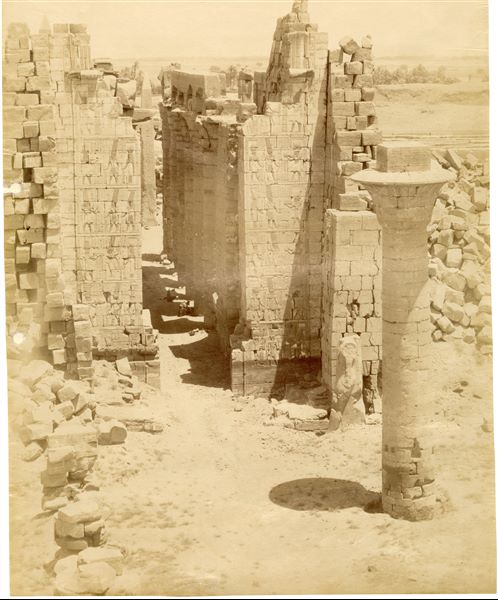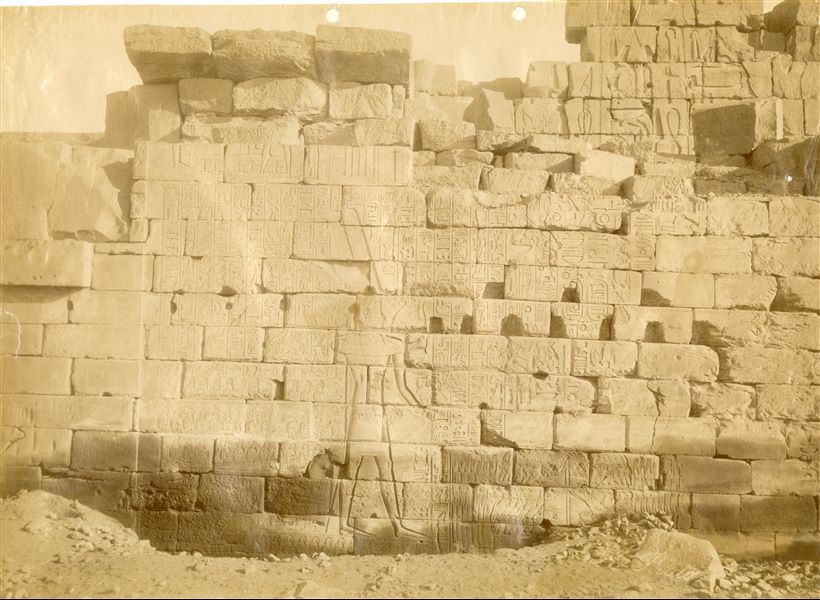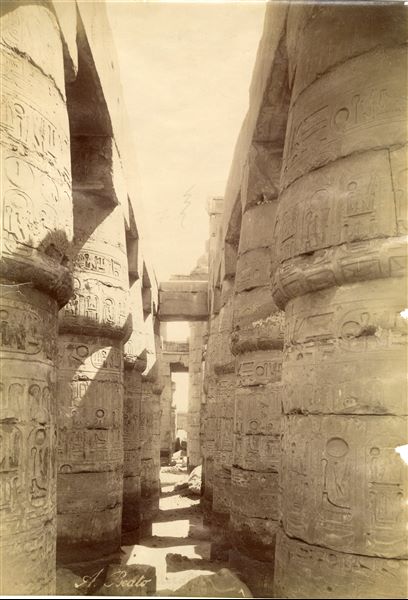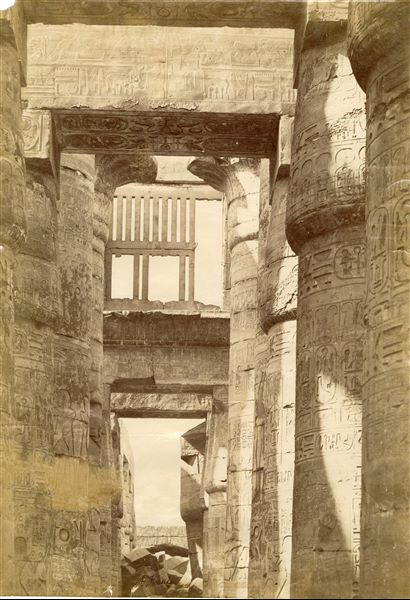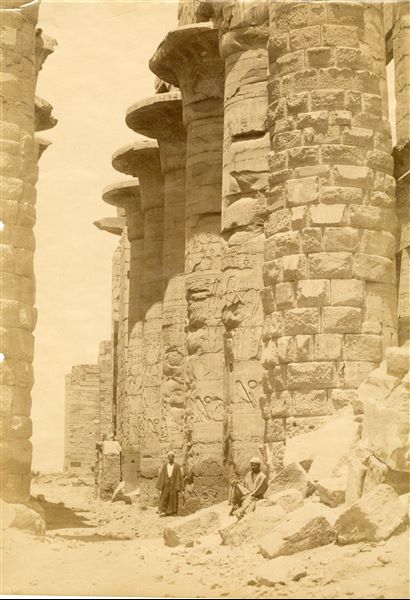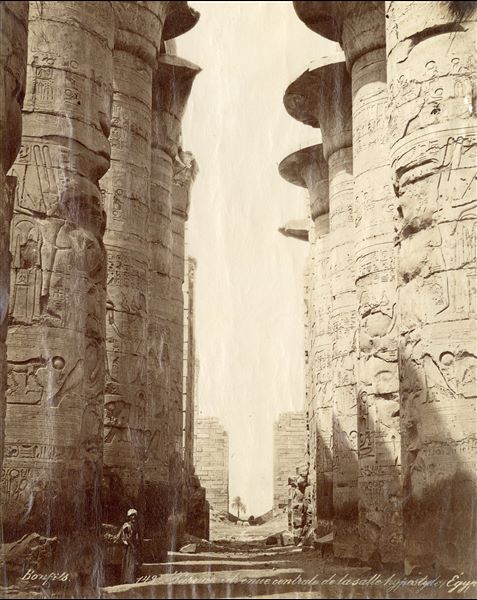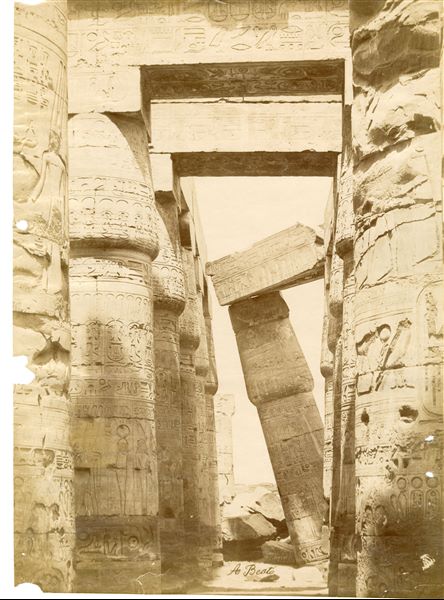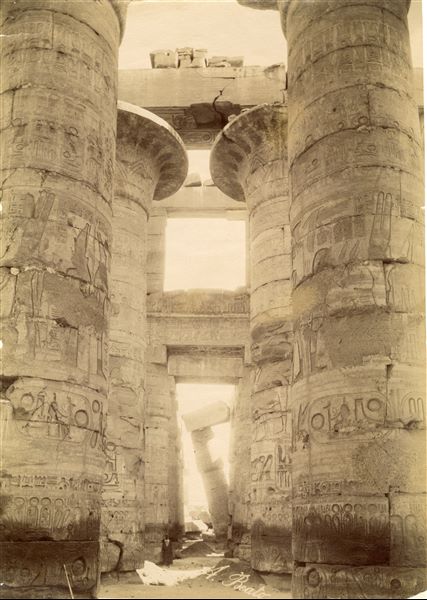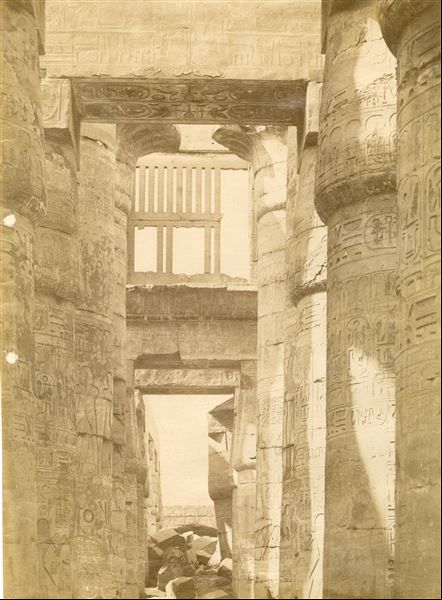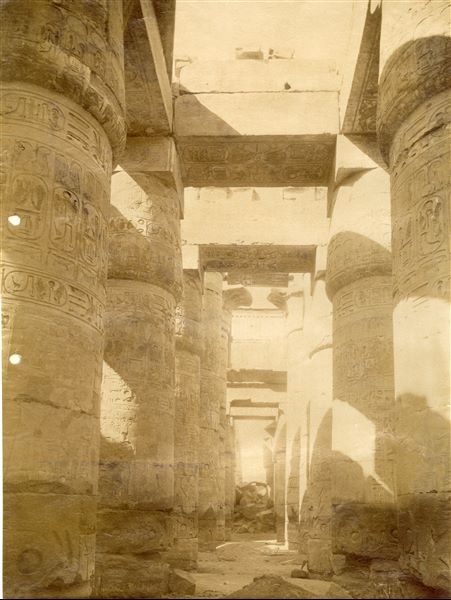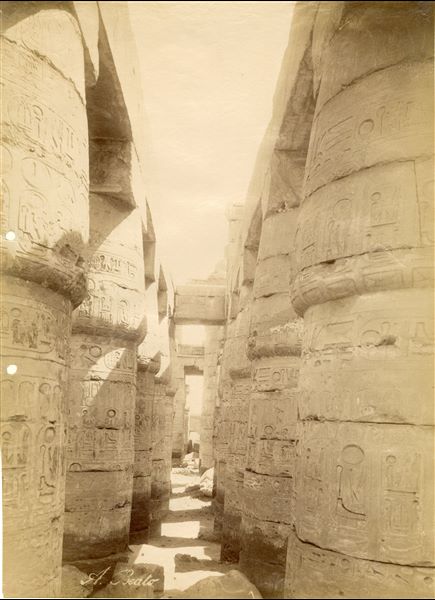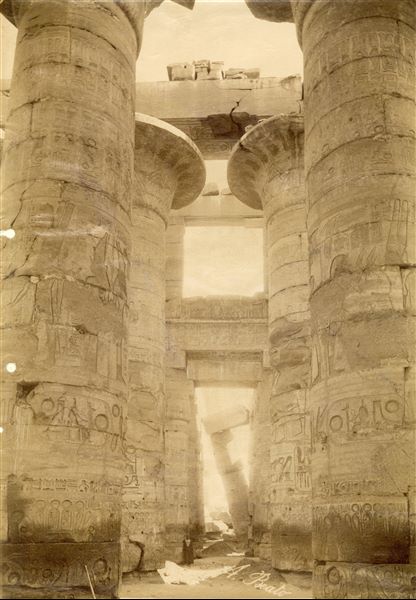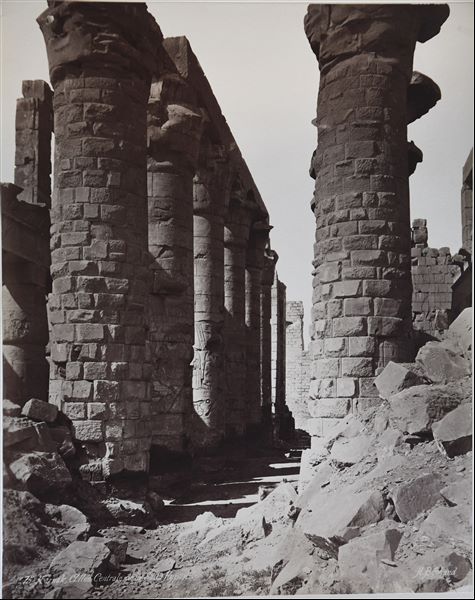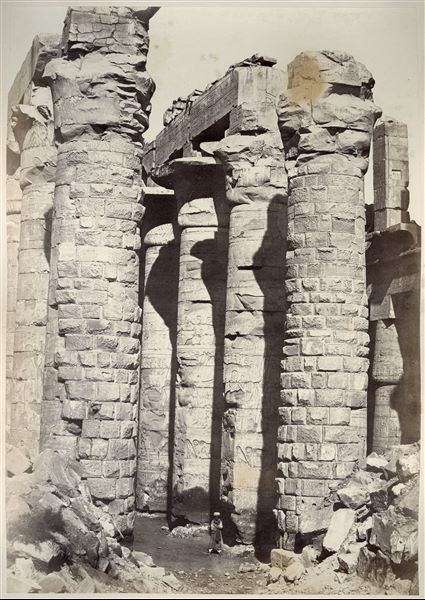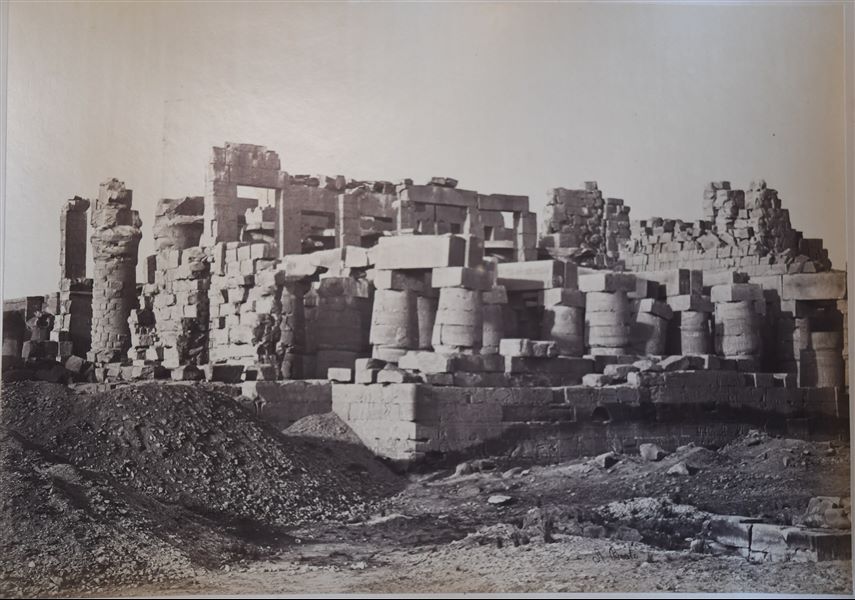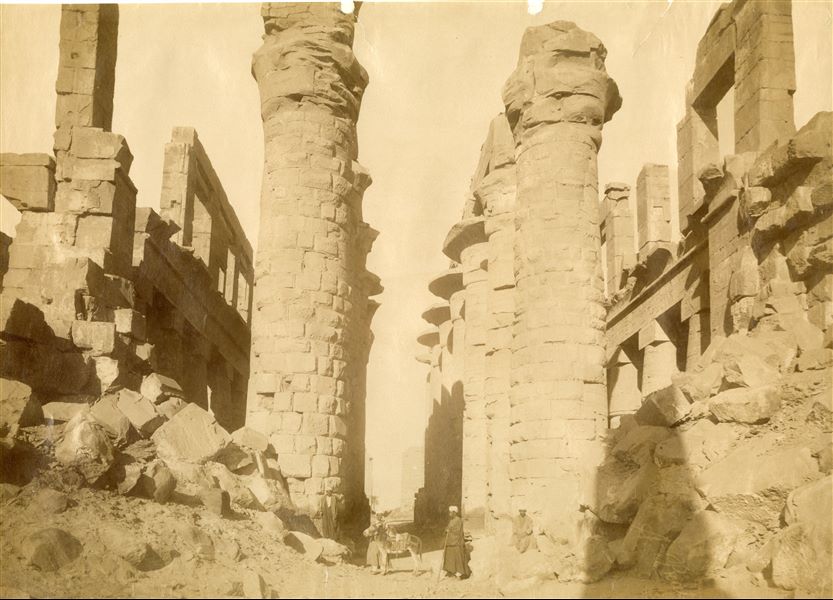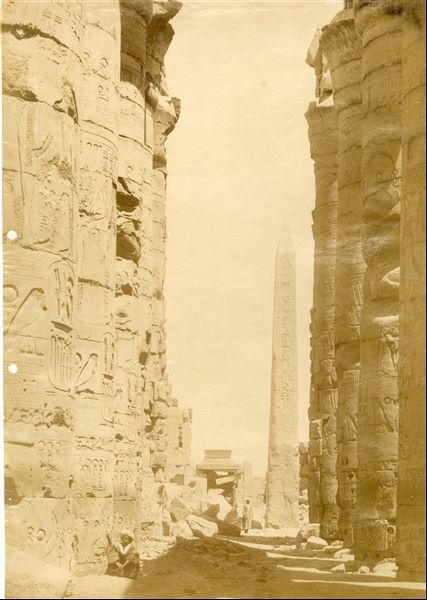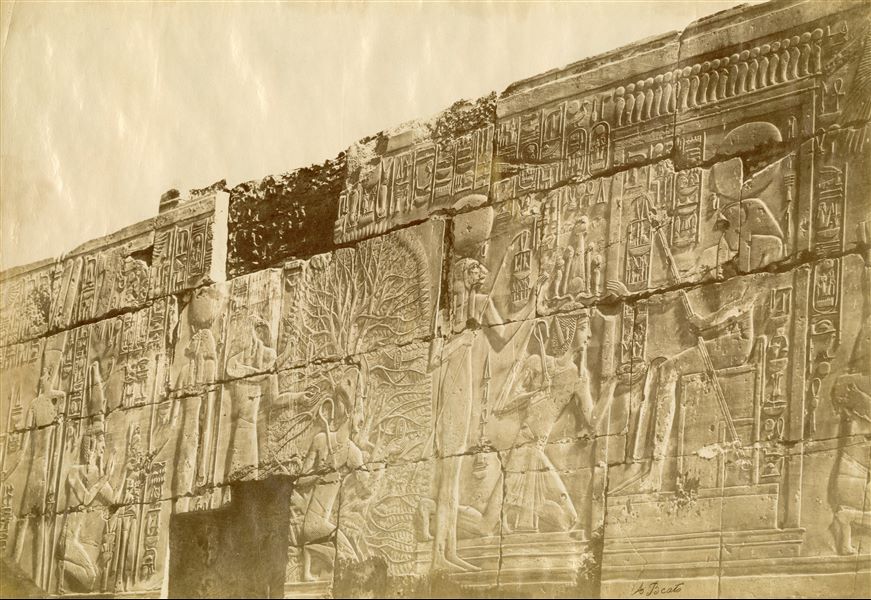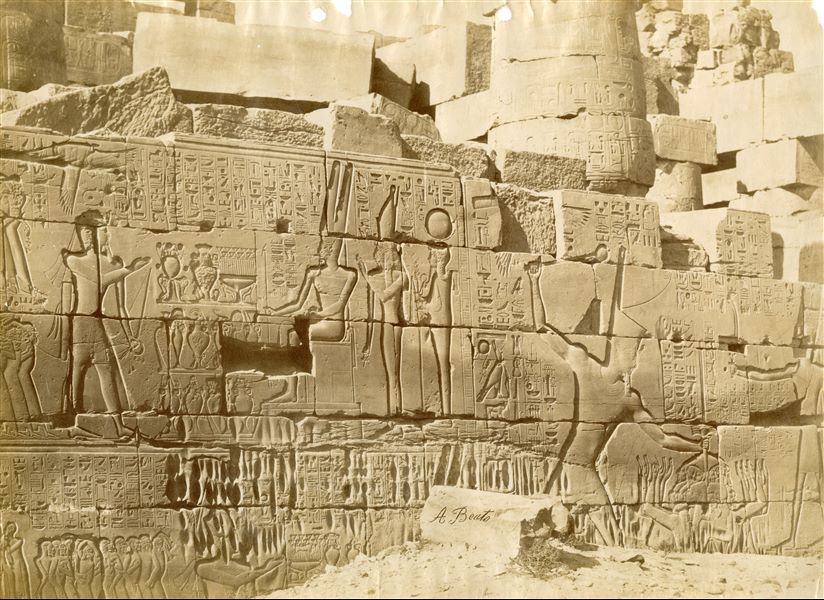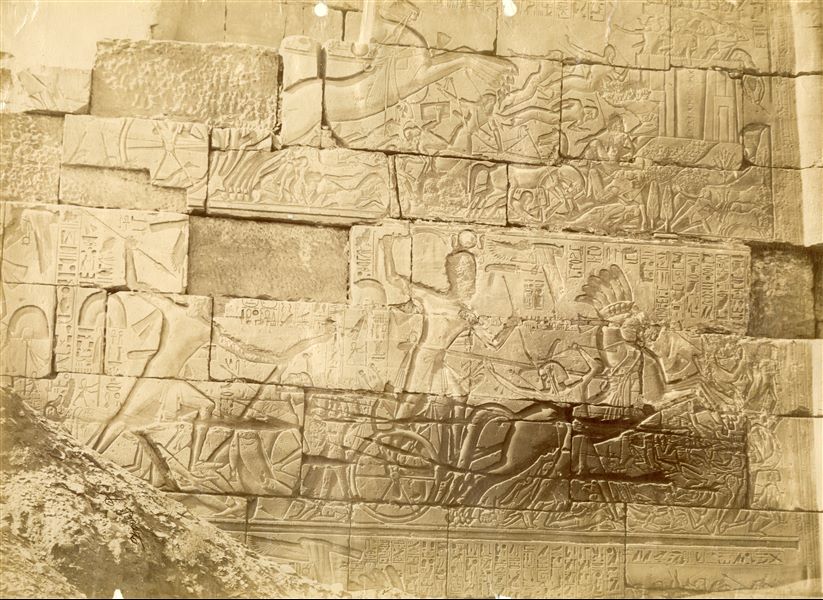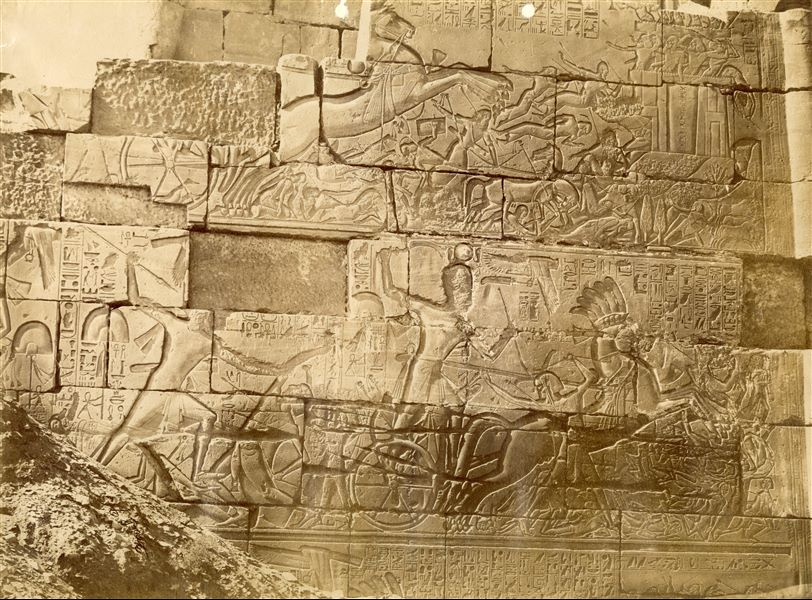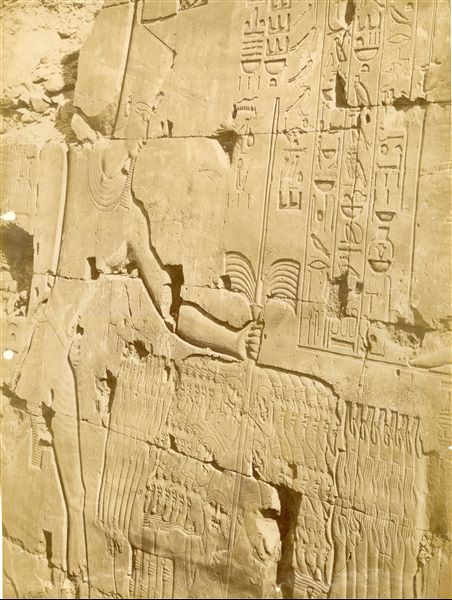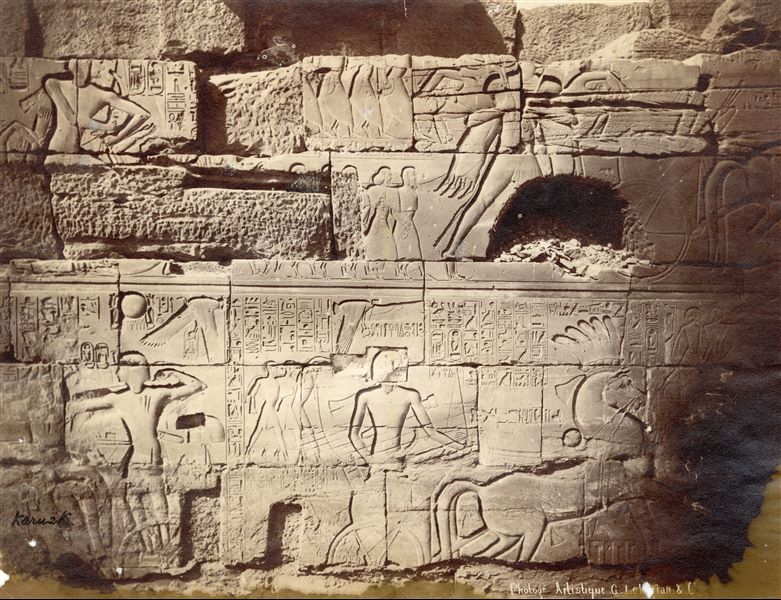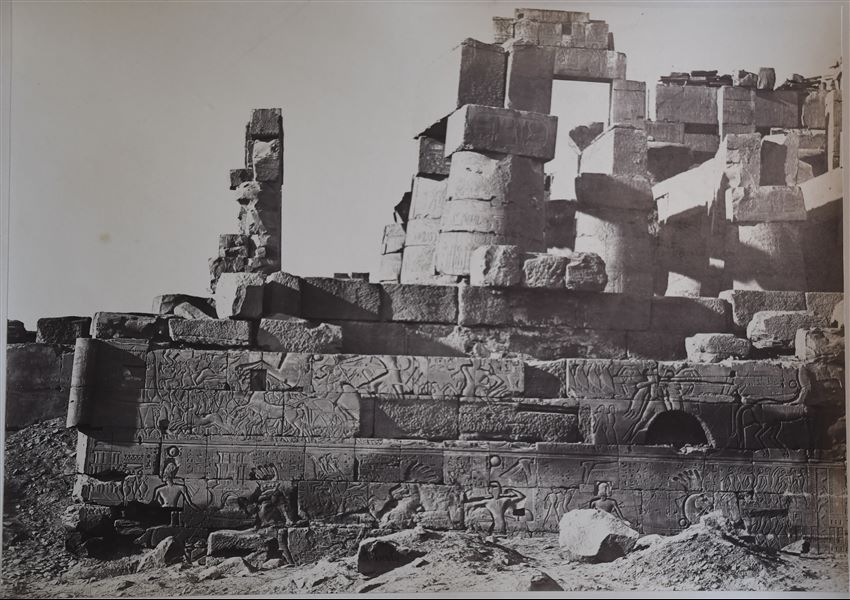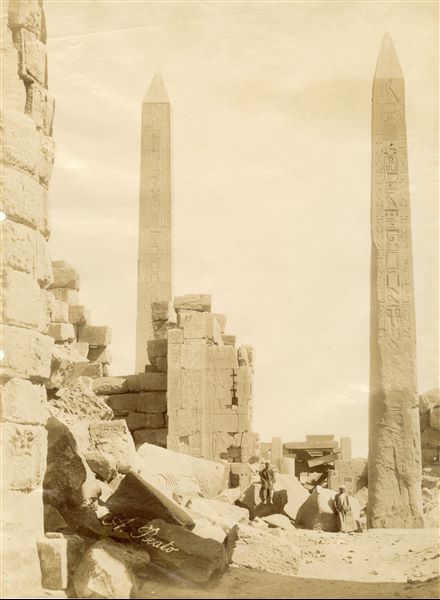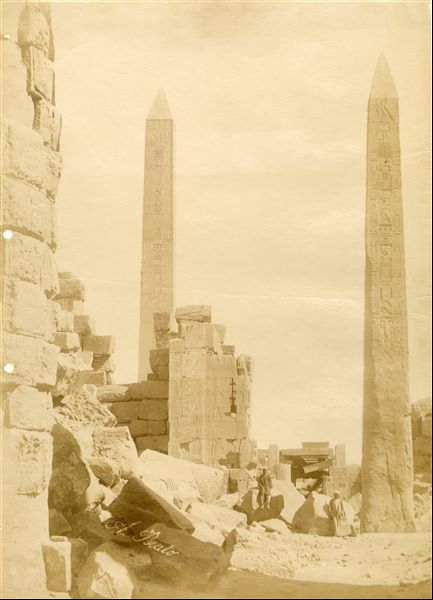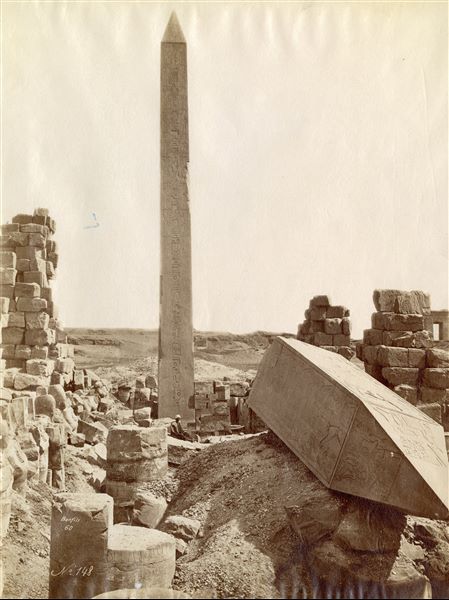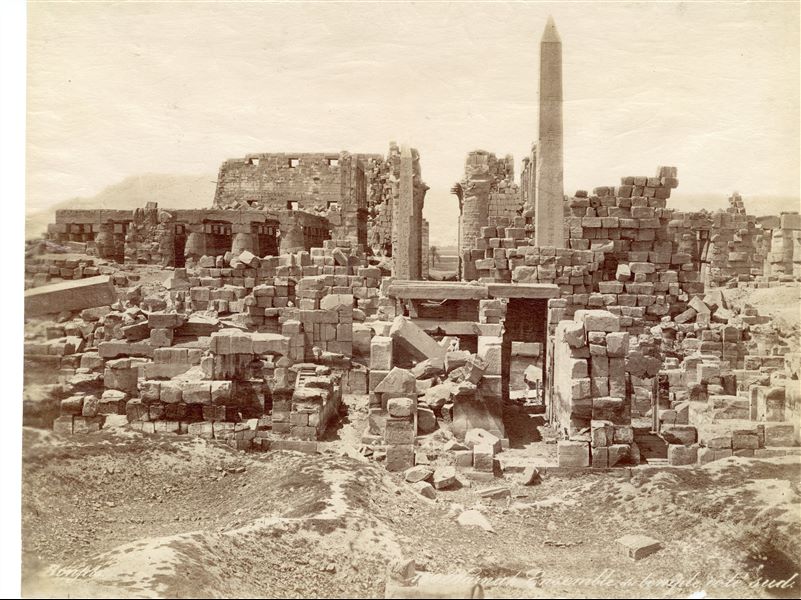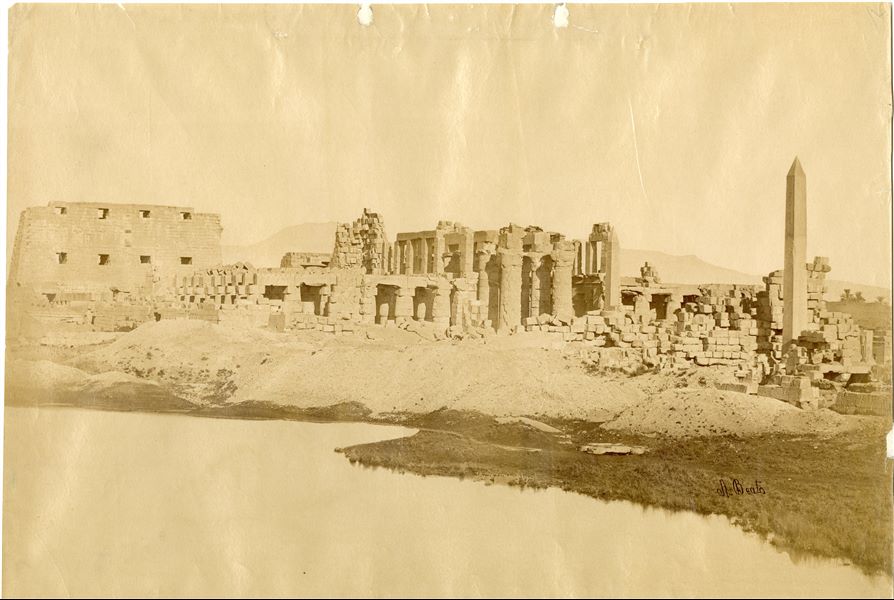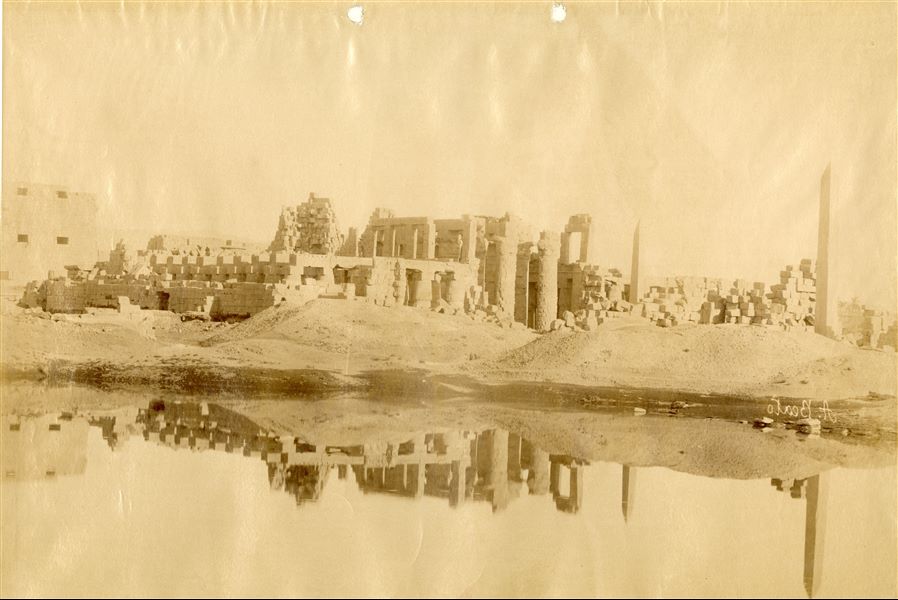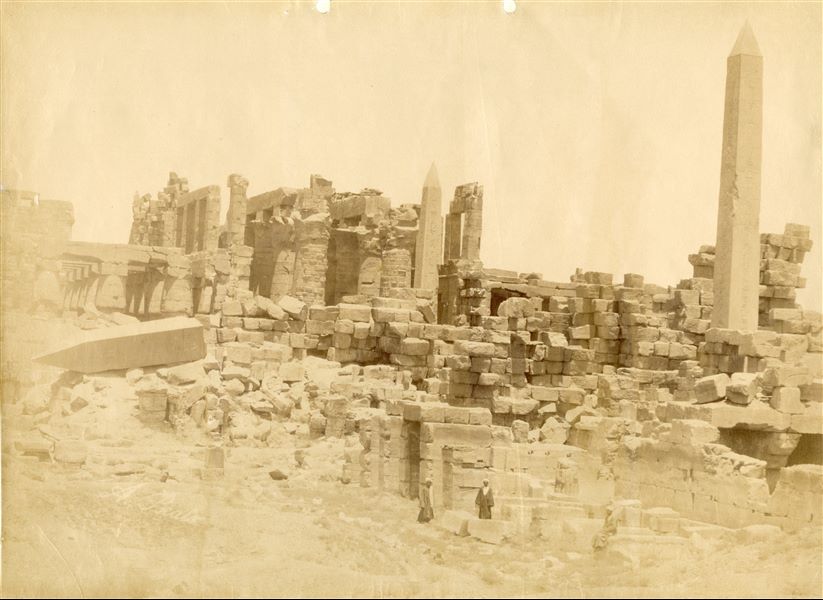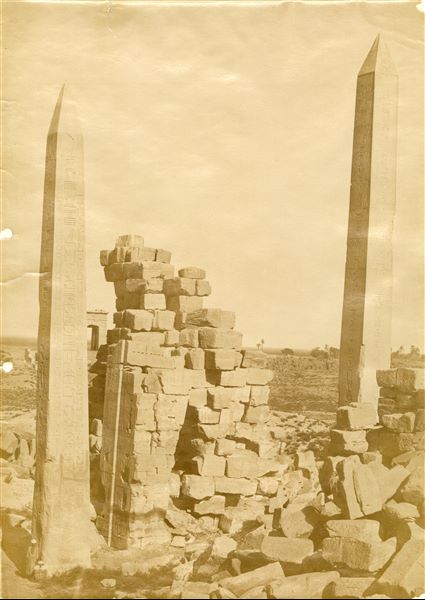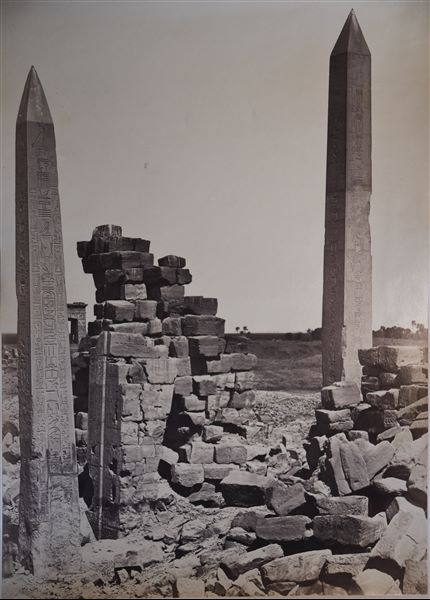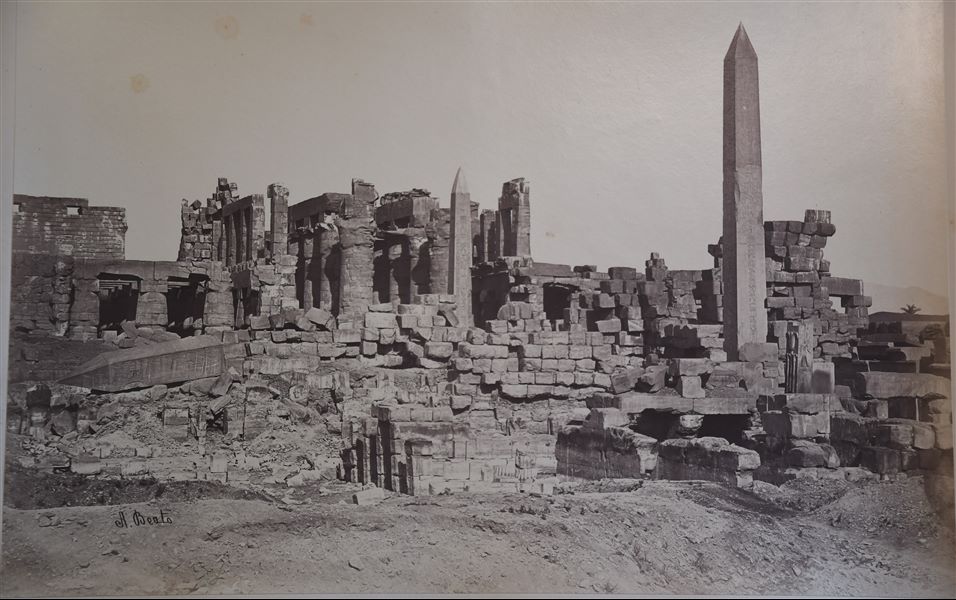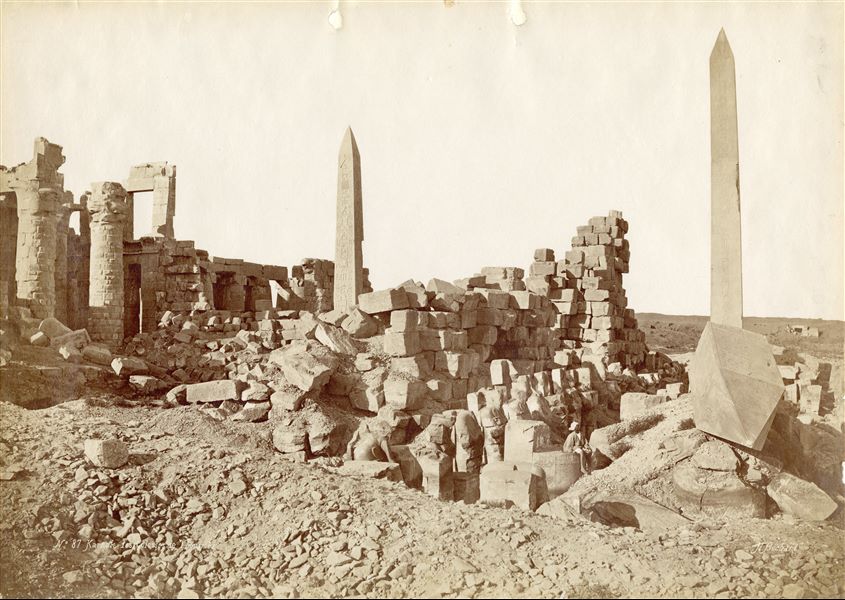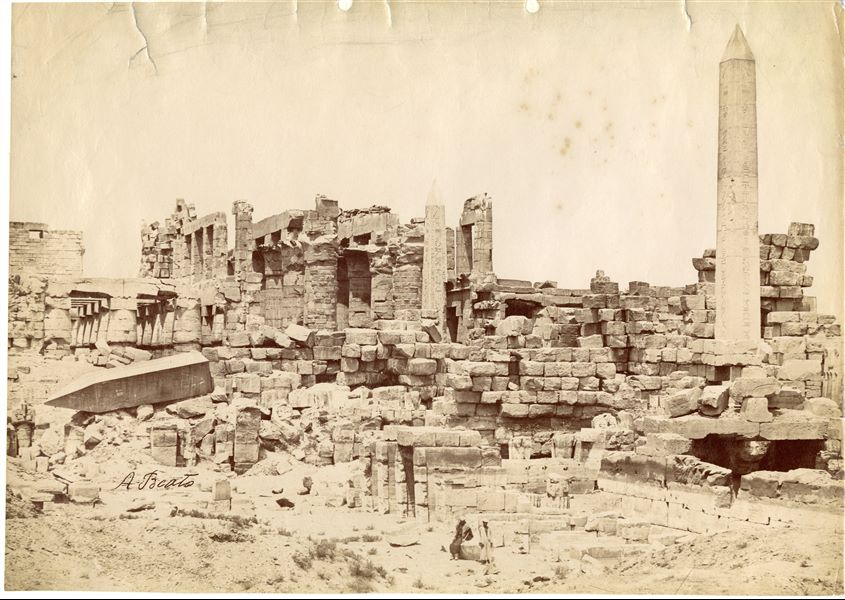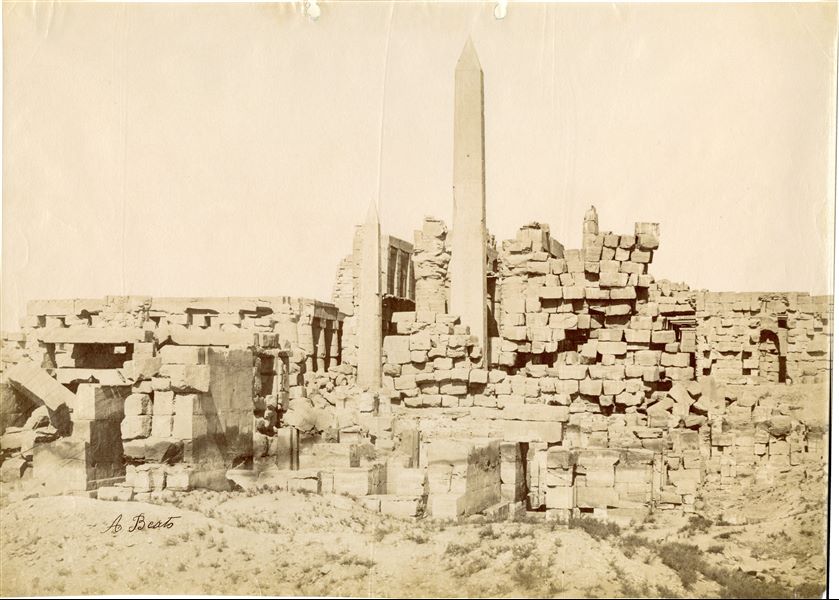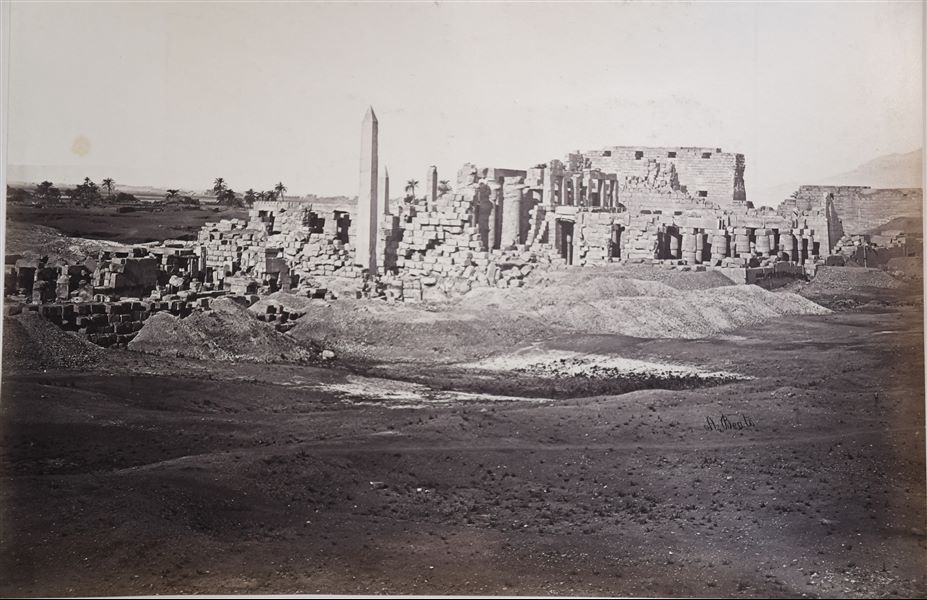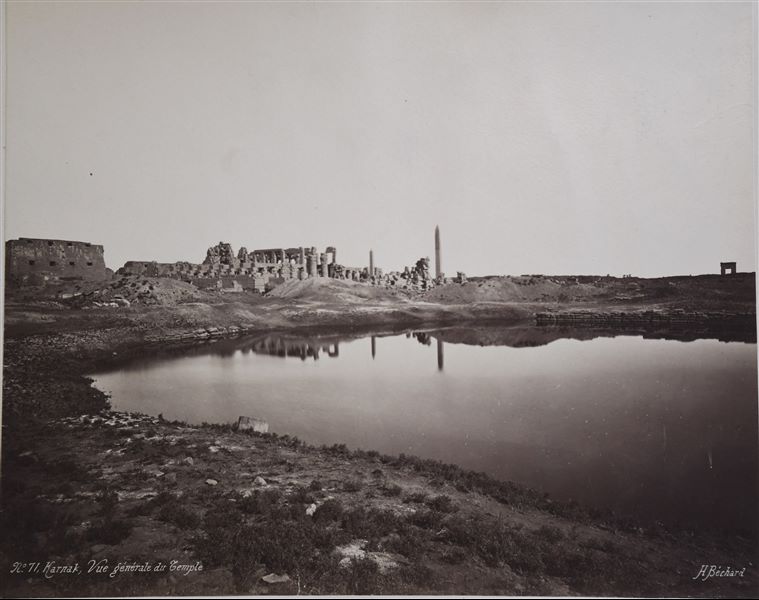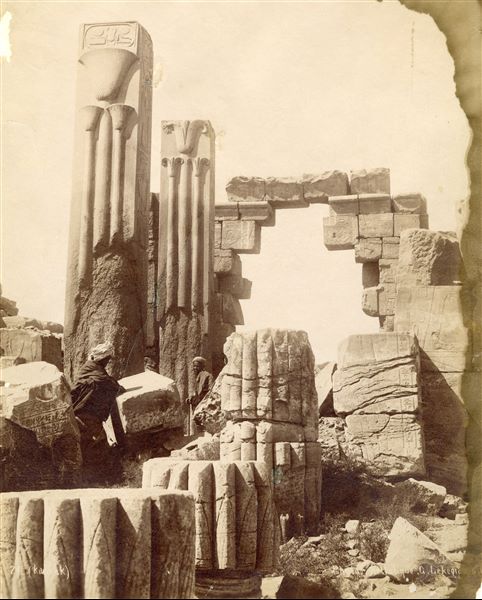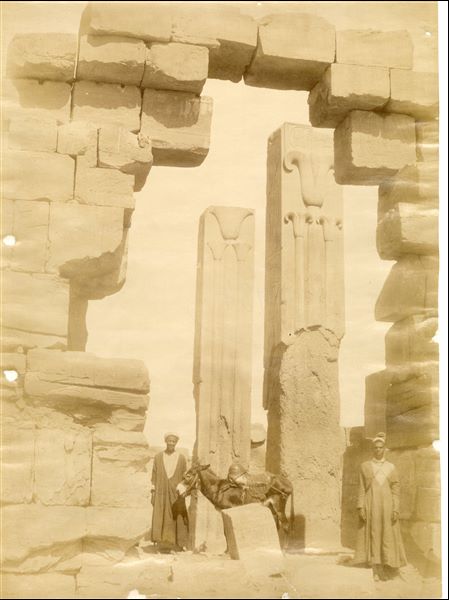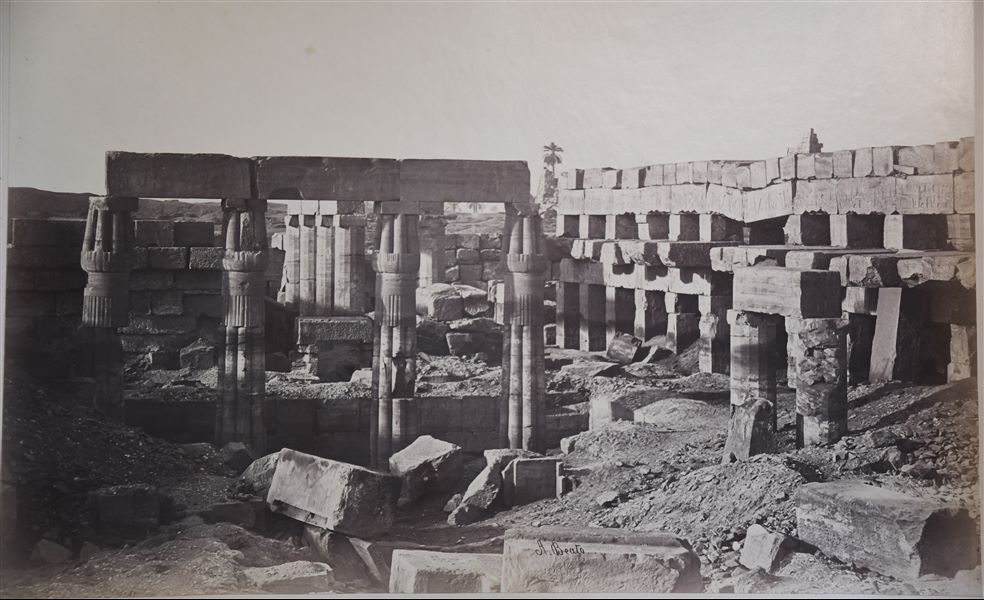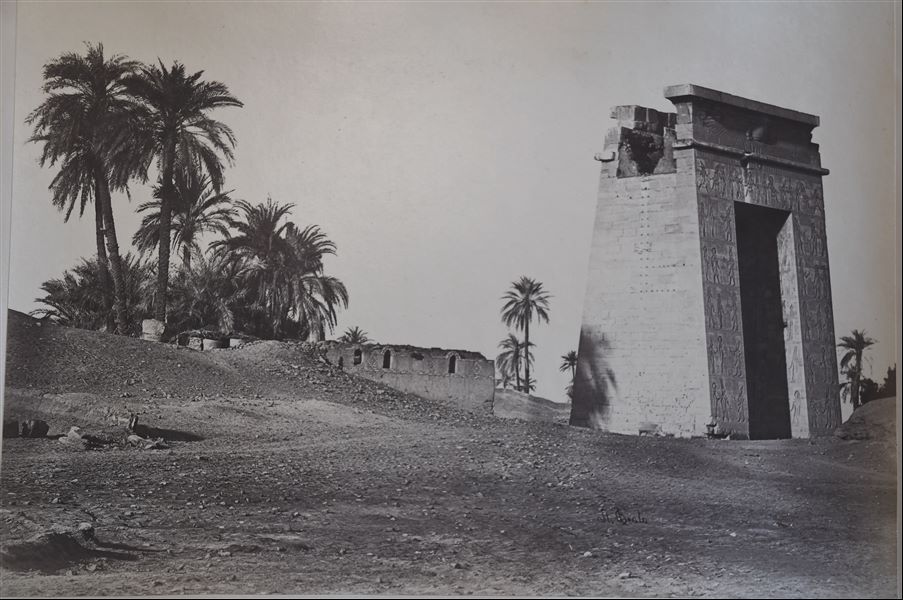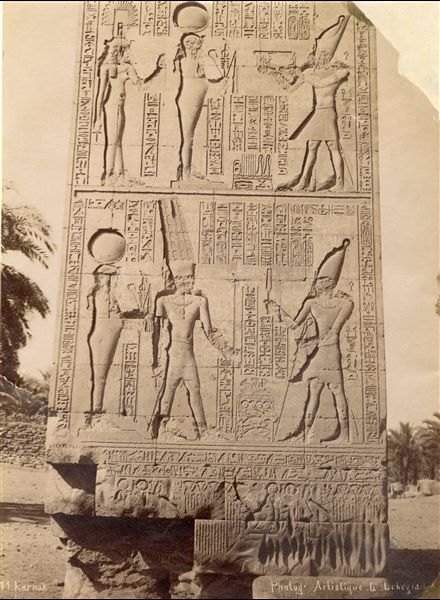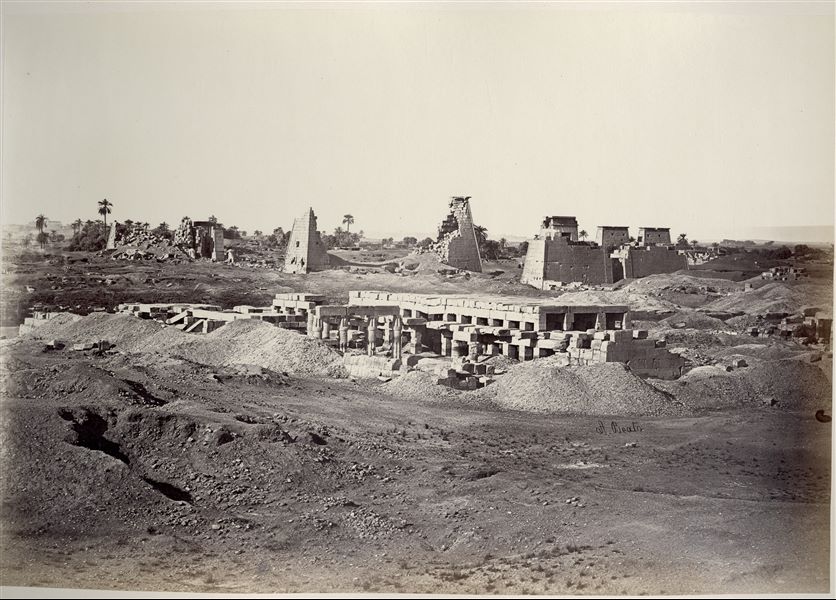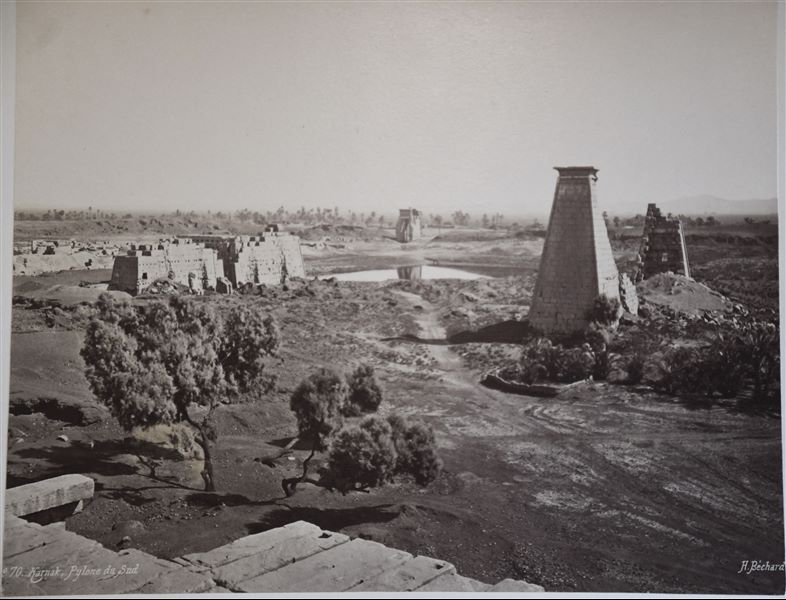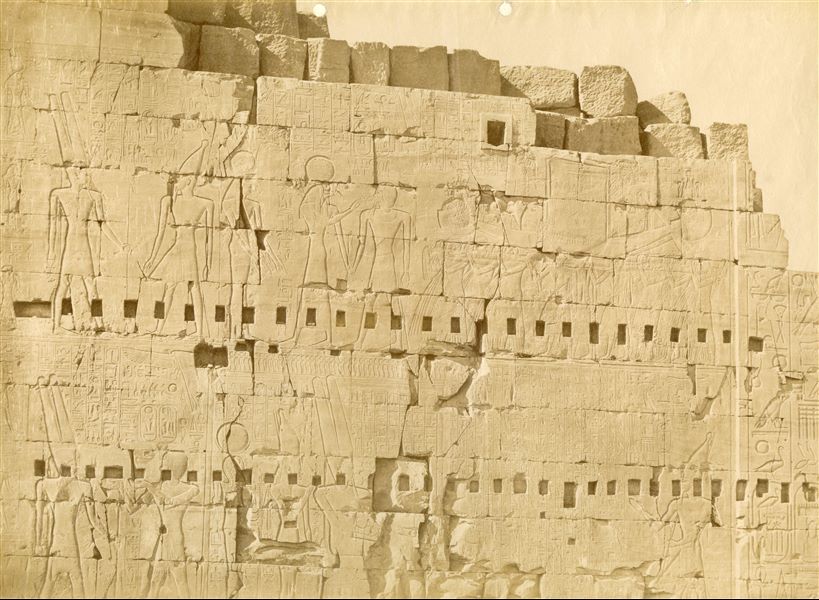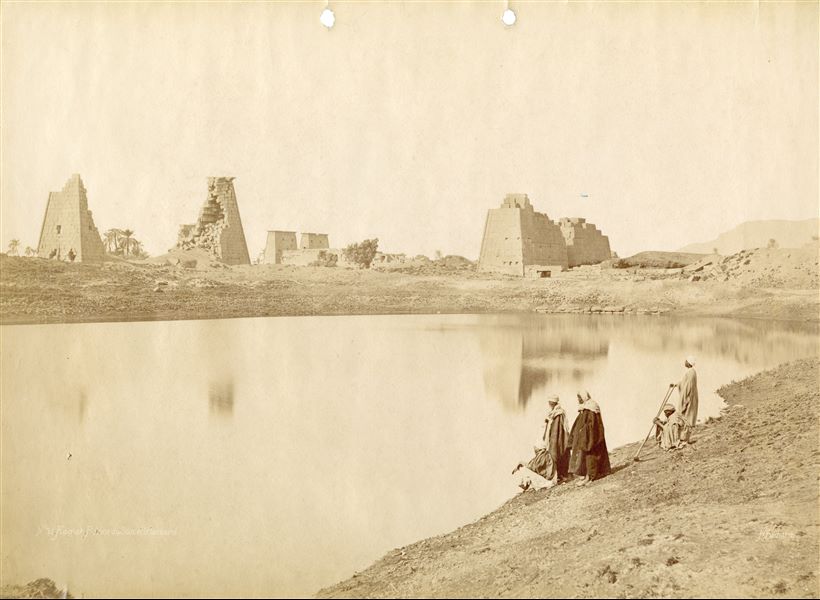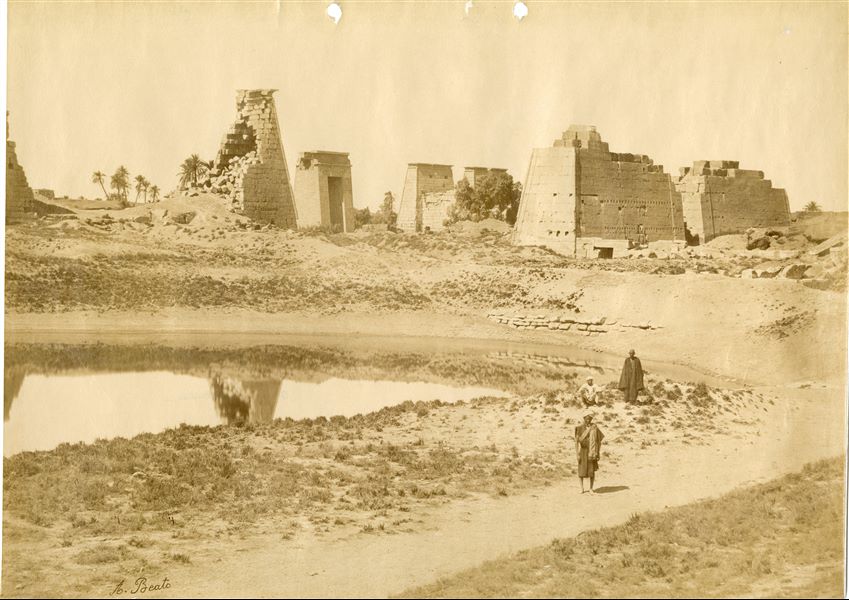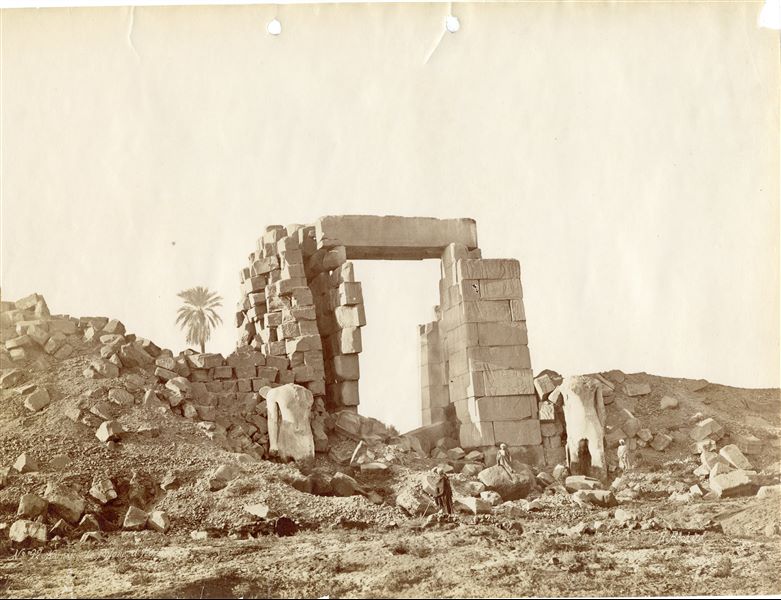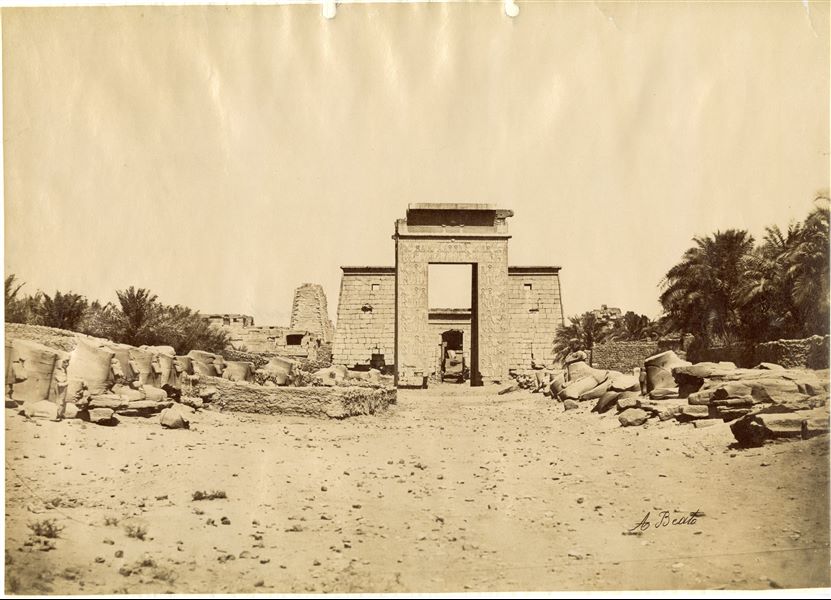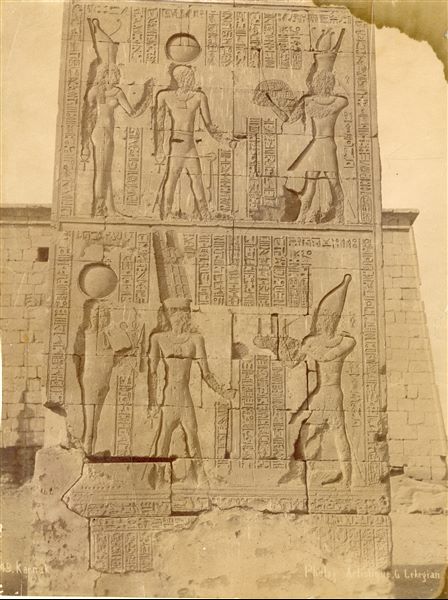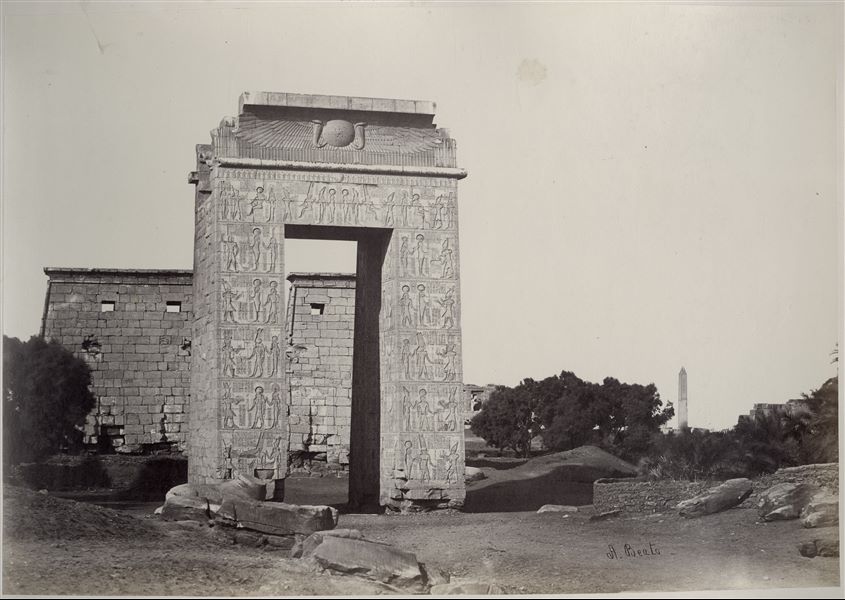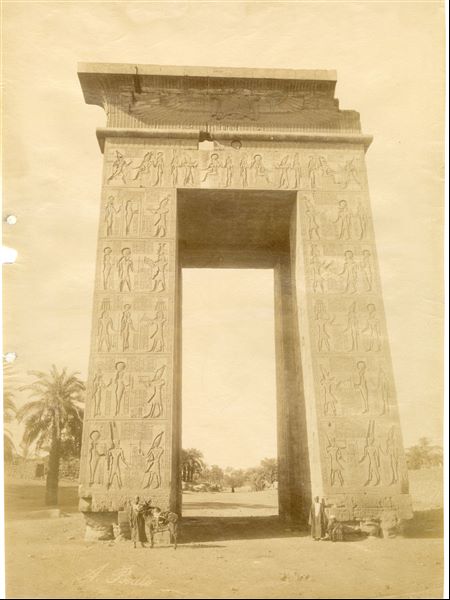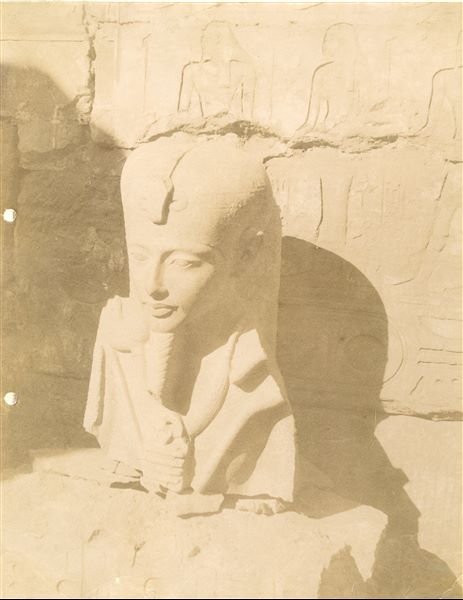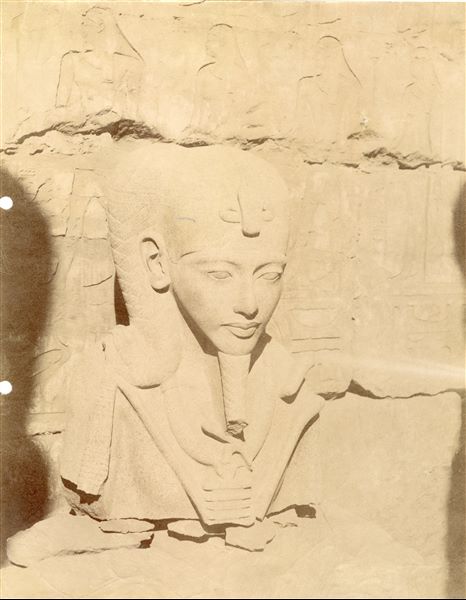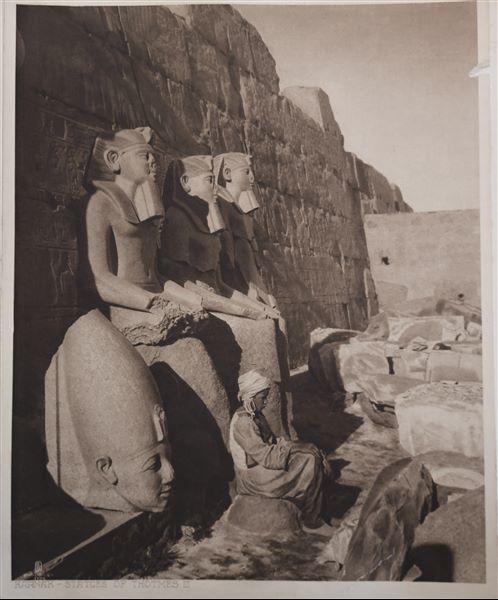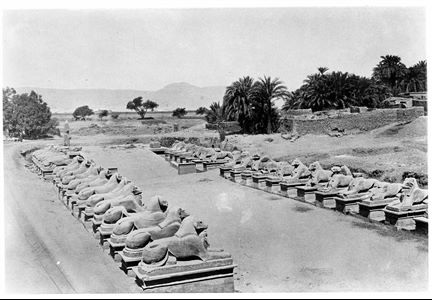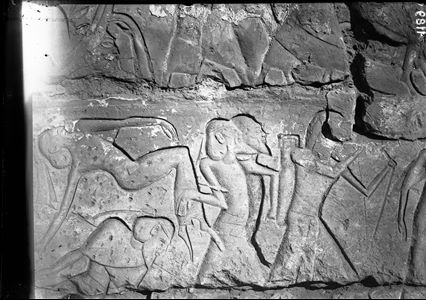The photograph shows the northern side of the Avenue of (ram-headed) Sphinxes at Karnak, in front of the entrance to the Karnak Temple Complex. A local inhabitant poses in front of the camera. The photograph could most probably be attributed to Antonio Beato.
The photograph shows a view of the Avenue of Sphinxes, with ram's head, in front of the Karnak Temple Complex. Based on the style, the photograph can be attributed to Antonio Beato.
The photo shows a view of the Avenue of the Sphinxes with ram's head at the Karnak Temple Complex, with two egyptians posing for the camera. In the foreground on the left, the rails that were used to clear the excavation area of debris are visible; a sign that work on the site had already begun. The author's signature which is mirrored, can be found at the bottom right.
The photograph shows the ram-headed sphinxes of the great avenue leading to the first pylon of the Karnak Temple Complex, with two local inhabitants among the ruins of the ancient monuments. The photo can be attributed to Antonio Beato.
The image depicts the façade of the first pylon of the Karnak Temple Complex, photographed from the Avenue of the Sphinxes, with a figure sitting among the ruins. In the background, the central corridor of the Great Hypostyle Hall can be seen, aligned with the entrance to the temple. The photograph can be attributed to Antonio Beato.
The photograph shows the main entrance to the Karnak Temple Complex (first pylon) from the Avenue of the Sphinxes with ram's head. This striking shot shows the ruins of the temple complex submerged in water during one of the Nile's floods. The photo can be attributed to Antonio Beato.
The photograph shows the collapsed second pylon in the first courtyard of the Karnak Temple Complex, where the Great Hypostyle Hall from the Ramesside period was built behind it. In the foreground, the last surviving column of the kiosk erected by Pharaoh Taharqa is visible. Behind the hall, in the background, the tips of the two obelisks still standing on site, those of Tuthmosis I and Hatshepsut can be seen.
The photograph depicts the entrance to the Great Hypostyle Hall, built by Pharaoh Seti I, dof the Karnak Temple complex, viewed from the courtyard in front. The remaining column from the south-eastern corner of the kiosk of Taharqa (ruler of the 25th dynasty) stands out. Some locals (seated and standing) and a donkey give an idea of the colossal size of the complex. The author's signature is visible at the bottom centre.
The picture shows the entrance to the Great Hypostyle Hall of the Karnak Temple Complex, seen from the first courtyard. The remaining column from the south-eastern corner of the kiosk of the 25th dynasty Pharaoh Taharqa stands out. Some locals give an idea of the colossal size of the complex. The author's signature is visible at the bottom.
The photograph shows the first courtyard of the Karnak Temple Complex, with the second pylon behind it and the Great Hypostyle Hall, with the remains of the kiosk of the Pharaoh Taharqa on the right (represented by the column still standing). All viewed from the first pylon, from which the complex is entered. The author's signature is visible at the bottom. Photograph probably taken from the top of the I pylon.
The first courtyard of the Karnak Temple Complex of is photographed here from the first pylon, through which the temple is entered. The remaining column of the kiosk of Pharaoh Taharqa (25th dynasty, called the “Ethiopian Dynasty") and the central corridor of the Great Hypostyle Hall, built by Pharaoh Seti I can be seen. In the background, the two obelisks, which are still standing are visible; those of Pharaoh Tuthmosis I (centre) and Queen Hatshepsut (of which only the tip, on the left, is visible). The author's signature (although very light and almost illegible) is at the bottom right.
Central axial view through the second pylon and the Great Hypostyle Hall of the Karnak Temple Complex. On the right, the only remaining column of the kiosk of Pharaoh Taharqa (25th dynasty, called the "Ethiopian" Dynasty). Along the central axis, at the bottom right is the still standing obelisk of Tuthmosis I. The author's signature is visible at the bottom centre.
Slightly off-axis view through the second pylon and the Great Hypostyle Hall of the Karnak Temple Complex. In the centre, the only remaining column of the kiosk of Pharaoh Taharqa (25th dynasty, called the "Ethiopian" Dynasty).
The photograph shows the southern wall of the eastern jamb of the so-called Bubastite Portal, in the Karnak Temple Complex , whose texts celebrate the military campaigns of Pharaoh Sheshonq I, ruler of the 22nd dynasty. The same ruler is depicted in the act of smiting Egypt's enemies. The ground level still covers part of the architecture. The author's signature (which is quite faded) is at the bottom right.
The photograph depicts a lateral intercolumniation within the Great Hypostyle Hall of the Karnak Temple Complex, built by Pharaoh Seti I in the 19th dynasty. The author's signature is at the bottom.
The photograph depicts a view of the Great Hypostyle Hall of the Karnak Temple Complex, particularly the distinctive "Window of Appearance". The author's signature can be found at the bottom.
The photograph shows the central colonnade of the Great Hypostyle Hall inside the Karnak Temple Complex, with two men probably positioned to show the sheer size of the columns. In the background, to the right, part of the second pylon is visible. The shot can be attributed to Antonio Beato.
The image shows a view of the central corridor of the Great Hypostyle Hall, built by Pharaoh Seti I, in the Karnak Temple Complex. A man in Egyptian clothing is looking towards the camera. The author's signature can be found at the bottom left.
The image shows part of the lateral colonnade of the Great Hypostyle Hall of the Karnak Temple Complex with papyrus columns which have not yet been completely cleared of sand. The author's signature can be found at the bottom.
The photograph shows a view of the colonnade, with papyrus columns not yet completely cleared of sand, from the Great Hypostyle Hall of the Karnak Temple Complex. The author's signature is at the bottom.
The photograph depicts six young Egyptians in front of a column in the Great Hypostyle Hall of the Karnak Temple Complex, with the cartouche of Pharaoh Ramessess II. The author’s signature is at the bottom.
The photograph shows the longitudinal section of the Great Hypostyle Hall of the Karnak Temple Complex together with the ruins of some collapsed walls. The authors' signatures can be seen at the bottom right.
Inside the Great Hypostyle Hall of the Karnak Temple Complex, built by Pharaoh Seti I and completed by his son and successor Ramesses II. Note, at the bottom centre where the author's signature is, some blocks obstructing the passage, as they have not yet been removed.
The photograph shows an interior view of the Great Hypostyle Hall, built by Pharaoh Seti I in the Karnak Temple Complex.
View of the colonnade of the Great Hypostyle Hall of the Karnak Temple Complex, where a local inhabitant poses in its shadow. Note that the ground level still covers the columns’ bases. The author's signature can be found at the bottom centre.
The photograph shows an interior view of the Great Hypostyle Hall of the Karnak Temple Complex, where the distinctive "Window of Appearance" can be seen at the top. Note that the ground level still covers the columns' bases. In the background are some debris and blocks that have not yet been put back in place.
The photograph shows a part of the of the colonnade inside the Great Hypostyle Hall of the Karnak Temple Complex, built by Pharaoh Seti I and completed by his son Ramesses II. Note that the ground level still covers the columns' bases. The author's signature can be found at the bottom.
The photograph shows the central columns of the Ramesside Great Hypostyle Hall built in the Karnak Temple Complex. The author's signature is visible at the bottom centre.
Bab al-Nasr, the “Gate of Victory”, one of the few surviving medieval gates from Cairo. The author's signature can be seen at the bottom right.
Detail of the central nave of the Great Hypostyle Hall from the Karnak Temple Complex, in the direction of the second pylon. The ground level still partially covers the columns' bases. The author's signature can be found at the bottom right.
Detail of the central nave of the Great Hypostyle Hall from the Karnak Temple Complex. The ground level still partially covers the columns' bases. The author's signature can be found at the bottom right.
Detail of some columns in the Great Hypostyle Hall from the Karnak Temple Complex. The ground level still partially covers the columns' bases. The author's signature can be found at the bottom right.
View of some remains of the Great Hypostyle Hall in the Karnak Temple Complex. The ground level still covers the lower part of the hall's perimeter wall. The author's signature is visible at the bottom right.
The photograph shows the central colonnade of the Great Hypostyle Hall in the Karnak Temple Complex, in the direction of the second and first pylons, with four egyptians and a donkey at the foot of the ruins. Note the accumulation of blocks on either side of the entrance. The author's signature can be found at the bottom right.
The picture shows a view of the central corridor of the Great Hypostyle Hall commissioned by Pharaoh Seti I in the Karnak Temple Complex, ending with the third pylon. In the forecourt between the third and fourth pylons, the surviving obelisk of Pharaoh Tuthmosis I is visible. The photo can be attributed to Beato.
The photograph depicts sacred images carved on the internal perimeter walls of the Ramesside Great Hypostyle Hall in the Karnak Temple Complex (north wall, east side). In the centre, Pharaoh Seti I, inside an ished tree writes his royal name on a leaf, together with the god Thoth. On the right, the pharaoh receives his “regnal years” from the gods Amun-Re and Weret-Hekau. The author's signature is visible at the bottom right.
The photograph depicts sacred images carved on the internal perimeter walls of the Ramesside Great Hypostyle Hall in the Karnak Temple Complex (north wall, east side). In the centre, Pharaoh Seti I, inside an ished tree writes his royal name on a leaf, together with the god Thoth. On the right, the pharaoh receives his “regnal years” from the gods Amun-Re and Weret-Hekau. The author's signature is visible at the bottom right.
The photograph shows the bas-reliefs on the outer wall (north side, east section) of the Great Hypostyle Hall in the Karnak Temple Complex. Showing battle scenes of Pharaoh Seti I against the Yenoam (first register from the top) and Shasu populations (second register from the top), who were slaughtered with the pharaoh's war chariot during his Syrio-Palestine campaigns. The photograph documents the ground level in the second half of the 19th century, which was a few metres higher than the original level. Part of the wall is in fact, still underground. At the bottom, the author's signature is visible.
View of part of the northern outer wall of the Great Hypostyle Hall of the Karnak Temple Complex, built by Pharaoh Seti I. The pharaoh is depicted during his military campaigns (right) and he is dedicating the victory over his enemies to Amun (top left). The author's signature is visible at the bottom centre.
View of a portion of the northern outer wall of the Great Hypostyle Hall of the Karnak Temple Complex. Pharaoh Seti I is depicted during his military campaigns (right) and he is dedicating the victory over his enemies to Amun (top left). The author's signature is visible at the bottom.
The photograph depicts a detail of the decoration of the outer wall, north side, of the Ramesside Great Hypostyle Hall in the Karnak Temple Complex. It shows Pharaoh Seti I in various stages of battle against the Syrio-Palestinians. Note that the ground level still covered part of the wall. The author's signature is clearly visible at the bottom left.
The image depicts some battle scenes of Pharaoh Seti I on the outer wall, north side, of the Great Hypostyle Hall in the Karnak Temple Complex. The author's signature is visible at the bottom left.
The image depicts some battle scenes of Pharaoh Seti I on the outer wall, north side, of the Great Hypostyle Hall in the Karnak Temple Complex. The author's signature is visible at the bottom left.
Detail of the decoration on the north outer wall of the Great Ramesside Hypostyle Hall from the Karnak Temple Complex. Pharaoh Seti I is depicted in the act of smiting his enemies - the Retenu (defeated during his Palestinian campaign). The signature of the author is at the bottom left.
The photograph shows a detail of the external wall’s decoration, north side, of the Great Hypostyle Hall built by Pharaoh Seti I in the Temple of Amun at Karnak, showing battle scenes against the Syrio-Palestinians. The author's signature is at the bottom right.
Northern exterior wall of the Great Hypostyle Hall in the Karnak Temple Complex. Pharaoh Seti I is depicted during his campaigns in Syria-Palestine. The ground level still covers the lower part of the wall. The author's signature is visible at the bottom.
The obelisks of the rulers Tuthmosis I (right) and Hatshepsut (left) in the Karnak Temple Complex. The author's signature is clearly visible at the bottom.
The photograph shows a view of the ruins from the Karnak Temple Complex, with the 18th dynasty obelisk of Pharaoh Tuthmosis I in the centre, and three local inhabitants posing next to the monument to give an idea of its size. In the background is the Great Hypostyle Hall. The author's signature is visible at the bottom.
The photograph shows a close view from the south of the area built by Pharaoh Tuthmosis I in the Karnak Temple Complex. The obelisk of the pharaoh (right) and that of Hatshepsut (left) are visible. The author's signature is at the bottom left.
The picture captures the two obelisks of Hatshepsut near the Wadjet Hall of Pharaoh Tuthmosis I in the Temple of Amun at Karnak, one obelisk is still intact, whilst the other (in the foreground) has its tip on the ground. An egyptian sits at the base of the monument in the background. A signature and presumably a date are visible at the lower left.
The photograph represents a view of the western wing of the Karnak Temple Complex, taken from the central courtyard where the Middle Kingdom temple was founded. Among the rubble stand the obelisks of Hatshepsut (right) and Tuthmosis I (left); the structures in the foreground correspond to the chapels of Hatshepsut and the sanctuary for the sacred boat of Philip Arrhidaeus. In the background, the columns of the Great Hypostyle Hall built by Seti I stand out. The author's signature (partially blurred) is at the bottom left.
The picture shows a set of structural elements that make up the Ramesside Great Hypostyle Hall from the Karnak Temple Complex, behind which the first pylon can be seen. In this frame, taken from the Sacred Lake, the obelisk of Hatshepsut and that of Tuthmosis I stand out in the foreground. The author's signature, written in a different style of calligraphy from the usual one is at the bottom right.
The picture shows what remains of the structural elements that make up the Ramesside Great Hypostyle Hall of the Karnak Temple Complex, behind which the first pylon can be seen. In this frame, taken from the Sacred Lake, the obelisk of Hatshepsut and that of Tuthmosis I stand out in the foreground. The author's signature which is mirrored can be found on the right.
The image shows the ruins of the Karnak Temple Complex, in particular the 18th dynasty buildings (right) and the Ramesside Great Hypostyle Hall (left). Among the ruins stand the obelisks of Hatshepsut (north, right) and Tuthmosis I (south, centre); note that the tip of the collapsed second obelisk of Queen Hatshepsut. Two egyptians look towards the camera lens. The author's almost completely faded signature is at the bottom left.
View of the south-western, external wall of the Great Hypostyle Hall built by Seti I in the Karnak Temple Complex, with one figure in the foreground and another at the height of the colonnade (in the background on the right). The ground level still covers part of the wall. The author's signature (partially cut off) is legible at the bottom.
The photograph shows the 18th dynasty obelisks in the Karnak Temple Complex seen from the south. The obelisk of Tuthmosis I is on the left and that of Hatshepsut is on the right. Two people, at the foot of the older monument, allow the photographer to demonstrate the size of the monuments. In the background, the Gateway of Ptolemy III is visible.
View of the two obelisks still standing in the Karnak Temple Complex, one of Pharaoh Tuthmosis I (left), the other of Queen Hatshepsut (right), in the middle are the remains of the fourth pylon. The author's signature can be seen at the bottom right.
General view of the Karnak Temple Complex, photographed from the Sacred Lake, in the direction of the Great Hypostyle Hall and the first pylon. In the background, the Theban mountain is visible.
View of the remains of the Great Hypostyle Hall, where three obelisks are clearly visible, two still standing (one of Tuthmosis I, centre, the other of Hatshepsut, right) and one collapsed (also belonging to Queen Hatshepsut), due to an earthquake during the Middle Ages. The author's signature is visible at the bottom left.
The photograph shows a view from the south of the Wadjet Hall of the Karnak Temple Complex, built by Pharaoh Tuthmosis I, as well as the two obelisks of Hatshepsut (one standing, the other collapsed). In the background in the centre, the surviving obelisk of Tuthmosis I is also visible. An egyptian sits on one of the plinths of the massive columns. The author's signature is visible at the bottom right.
The photograph shows an eastern view of the colonnaded Wadjet Hall built by Pharaoh Tuthmosis I in the Karnak Temple Complex. The still standing obelisks of Hatshepsut (north, on the right), the tip of he collapsed one (south, on the left) and that of Tuthmosis I (centre) are also visible. In the background, the western ruins of the Great Hypostyle Hall of Seti I can be seen. Two egyptians seated on a boulder in front of the temple, pose for the photographer, whose signature is legible on the left.
View of the western wing of the Karnak Temple Complex, from the central courtyard on which the Middle Kingdom temple was founded. Among the rubble stand the obelisks of Hatshepsut (centre) and Tuthmosis I (left), and behind them the impressive Great Hypostyle Hall of Pharaoh Seti I. The structures in the foreground correspond to the chapels of Hatshepsut and the sanctuary for the sacred boat of Pharaoh Philip Arrhidaeus (left), Alexander the Great's half-brother and his successor. The author's signature is visible at the bottom left.
View of a part of the Karnak Temple Complex. Standing out in the centre are the remains of the Wadjet Hall, the Great Hypostyle Hall, and behind it, the remains of the second pylon. On the left, there are two obelisks, one erected by Tuthmosis I, the other by Queen Hatshepsut. The Nile can be seen in the background. The author's signature is on the right.
General view of the main axis of the Karnak Temple Complex, including the columns of the Great Hypostyle Hall, photographed from the Sacred Lake. Between the Sacred Lake and the Great Hypostyle Hall, the remains of the seventh pylon can be seen. The author's signature is visible at the lower right.
The photograph shows a detail of the wall decoration from the Karnak Temple Complex, in the “Sanctuary of the sacred boat” of Philip Arrhidaeus, depicting ceremonial scenes of presenting the King to Amun and the transport of the sacred boat. Based on the style, the photograph can be attributed to Antonio Beato.
The image shows the ruins of the vestibule built by Tuthmosis III in the Karnak Temple Complex, where the pink granite pillars bearing the emblems of Upper Egypt (right) and Lower Egypt (left) are visible, respectively, the lotus for the South and the papyrus for the North. Above, the cartouche of Tuthmosis III. Two egyptians are present at the foot of the columns. The authors' signature is legible at the bottom right.
The image shows the ruins of the vestibule built by Tuthmosis III in the Karnak Temple Complex. In particular, the monolithic pink granite pillars bearing the emblems of Upper Egypt (right) and Lower Egypt (left) stand out, with the Lotus and Papyrus respectively. The photo can be attributed to Antonio Beato.
In the image there are some Egyptians among the ruins of the Akhmenu (“Festival Hall”), the temple built by ruler Tuthmosis III within the Karnak Temple Complex. Among the ruins, four papyrus columns are still standing. The photograph can be attributed to Antonio Beato.
The picture shows the ruins of the Akhmenu (“Festival Hall”), the temple built by ruler Tuthmosis III in the Karnak Temple Complex. Among the ruins, four papyrus columns are still standing. The author's signature can be found at the bottom.
Photograph of the western gate of the Karnak Temple Complex, built by Ptolemy IV. The author's signature is at the bottom right.
The photograph depicts a detail of decorated relief on the western gate built by King Ptolemy IV on the walls of the Karnak Temple Complex. The author's signature is at the bottom right.
Panorama of the Karnak Temple Complex. In the foreground, the ruins of the Akhmenu (“Festival Hall”), the temple built by ruler Tuthmosis III in the Karnak Temple Complex for his own jubilee, and the “sancta sanctorum” in the Temple of Amun. In the background, from the right, the seventh pylon (very faintly visible, being almost completely destroyed) as well as the eighth, ninth and finally tenth pylons. On the left in the background, the Temple of Luxor is visible. The author's signature can be found at the bottom right.
View of the Karnak Temple Complex, from the north-south axis. In particular, the remains of the seventh (far left), eighth (left) and ninth pylons (centre) are visible. Behind, the Sacred Lake, and in the background is the gate built by Nectanebo I. Photograph taken from the Temple of Khonsu. The author's signature can be found at the bottom right.
Detail of the inscriptions on the northern façade, east side, of the eighth pylon in the Karnak Temple Complex. The reliefs show pharaohs Tuthmosis I and Seti I (upper register), Tuthmosis II and Seti I (lower register) performing rituals and praying to the gods, including Amun. Queen Hatshepsut was depicted but then later replaced with the name of Tuthmosis II.
The image shows five Egyptians on the bank of the Sacred Lake of Karnak in the Karnak Temple Complex. In particular the eighth pylon (on the right, that of Queen Hatshepsut) and ninth pylon (left, that of Pharaoh Horemheb). In the background, the ruins of the Temple of Khonsu can be see within the Complex, where the pylon and the eastern outer enclosure walls are visible. The author's signature can be found at the bottom right.
The photograph depicts the ruins of two pylons in the Karnak Temple Complex, seen from the Sacred Lake, specifically the ninth pylon (left, that of Pharaoh Horemheb) and the eighth pylon (right, that of Queen Hatshepsut). In the background, centre, the southern gate commissioned by Ptolemy III Euergetes to access to the Temple of Khonsu, from where the pylon is visible. The perspective however, is distorted but the two monuments are aligned. Three egyptians on the bank of the slightly drained Sacred Lake look towards the camera lens. The author's signature is visible at the bottom left.
The picture shows the northern side of the tenth pylon in the Karnak Temple Complex, built by Pharaoh Horemheb with two colossal statues of the pharaoh (later reused by Ramesses II) on either side of the gate, the only architectural element of the pylon still visible. The presence of some egyptians give an idea of the large size of the monument. The author's signature is visible at the bottom right.
The photograph shows the northern side of the yet to be restored tenth pylon in the Karnak Temple Complex, built by Pharaoh Horemheb, with two colossal statues of the pharaoh (later reused by Ramesses II) on either side of the gate. The ground level still covers the lower part of the colossal statues. The author's signature is visible at the bottom left.
The photograph was taken in the direction of the Avenue of the Sphinxes with ram's heads, facing towards the Temple of Khonsu at Karnak. The southern gate of the sacred enclosure of the Karnak Temple Complex and the entrance to the Temple of Khonsu can be made out. The author's signature is visible at the bottom.
The image shows the Avenue of Sphinxes with ram's heads, leading to the southern entrance, built by Ptolemy III Euergetes, in the Karnak Temple Complex. In the background, the entrance to the Temple of Khonsu is visible, aligned with the entrance. Some egyptians look towards the camera lens, while others continue their work.
The photograph shows the southern gate built by Ptolemy III, and behind it, the pylon of the Temple of Khonsu inside the Karnak Temple Complex. The author's signature is visible at the bottom left.
The photograph shows a detail of the inscriptions on the southern entrance gate to the Karnak Temple Complex, built by Pharaoh Ptolemy III Euergetes. Behind the monument, the eastern side of the façade of the Temple of Khonsu is visible. The author's signature is visible at the bottom right.
Photograph of the entrance gate to the Karnak Temple Complex built by Ptolemy III Euergetes, behind this stands the Temple of Khonsu. The author's signature, visible at the bottom left is written backwards.
Photograph of the entrance gate to the Karnak Temple Complex built by Ptolemy III Euergetes. The author's signature, visible at the bottom left is written backwards.
The photograph shows the entrance gate, on the southern side, built by Ptolemy III Euergetes in the Karnak Temple Complex. Some egyptians are photographed next to the darkroom, the black curtain visible next to the gate was perhaps used for developing film. Based on the style of the handwriting, the work can be attributed to F. Bonfils.
A photograph of the western gate to the Karnak Temple Complex, built by Pharaoh Ptolemy IV. Some Egyptians and a donkey are posing in front of it, giving an idea of the colossal proportions. The author's signature is visible at the bottom left.
The photograph shows the fragmentary bust of a statue of the god Khonsu depicted in the likeness of Tutankhamun, found in the Karnak Temple Complex. Thanks to the discovery of additional fragments in the 1904 Legrain excavations, the sculpture was later re-assembled and is now in the Egyptian Museum in Cairo (Cairo CG 39488).
The photograph presents a close-up of the fragmentary bust of the statue of the god Khonsu, depicted in the likeness of Tutankhamun, in the Temple of Amun at Karnak.
Detail of three statues and a colossal head of Pharaoh Tuthmosis III, found in the Karnak Temple Complex.
The photograph depicts a group of Egyptians in the shade of a palm grove on the banks of one of the Nile’s canals. As stated in the caption on the back of the photograph; the village of Karnak is evident in the background, where some remains of ancient columns can be seen.
Landscape view of the village of Karnak, in Luxor. In the background the remains of the Karnak Temple Complex are visible, including an obelisk (left), and the massive structure of the Great Hypostyle Hall. The author's signature can be found at the bottom left.

